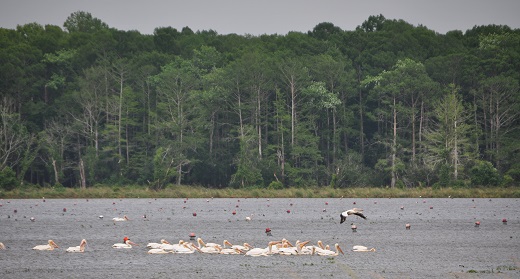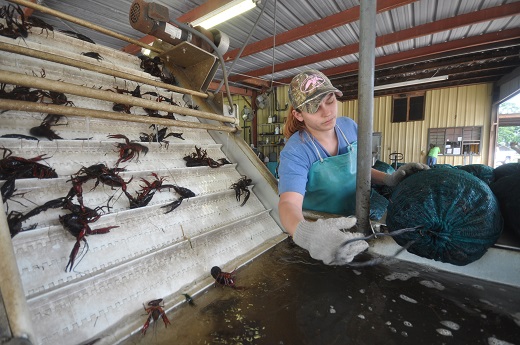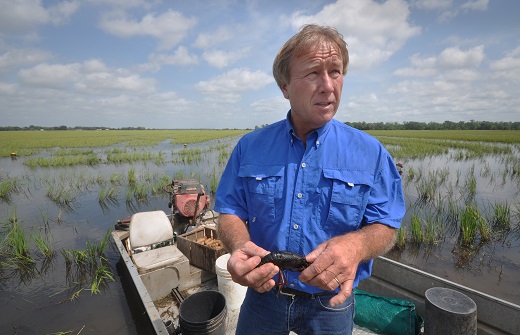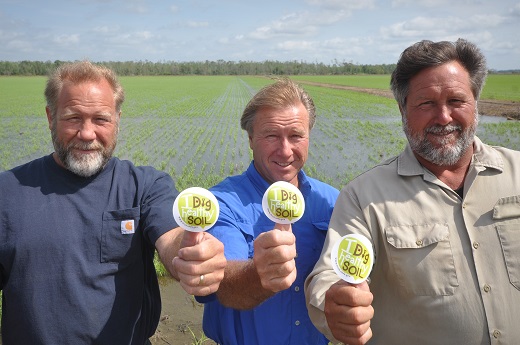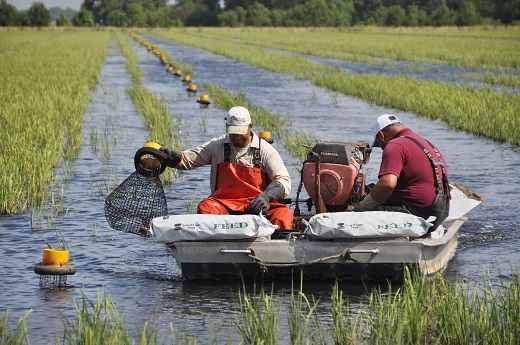
Photo by Ron Nichols
Soil Health for the Future
While rice and crawfish farming offer unique soil health management challenges, the Durand’s are undaunted in their desire to improve the health of the resource they see as the future of their family’s farming operation.
“Soil health gives us the ability to grow a good crop, to be sustainable for the future,” says Jeff Durand. “We have to take care of the soil we’re blessed with to grow food for our families, our neighbors and the world – so it can be productive for generations to come.”
Jeff, along with his brothers, Greg and C.J., began farming with their father in the early 1970s, raising exclusively crawfish. By 1980, the Durand’s began growing rice as part of their farming operation. From the beginning, the Durand’s utilized no-till rice planting.
To ensure proper water depth and distribution across the fields, precision land-leveling is a necessary practice in both rice and crawfish production. Unfortunately, that requires excavating some higher areas of the fields, which removes soil organic matter and adversely affects soil health.
The Durand’s initially began looking for ways to improve soil health in the excavated areas of their fields, but the more they learned about restoring soil health in low-yielding areas, the more they realized those principles could be applied to their higher-yielding areas, too.
Durand now hopes these soil health practices will translate into greater farm profitability overall.
“Through no-till practices alone, we know we’re using less fuel. There’s less wear-and-tear on the equipment, less labor and we’re more efficient overall,” Durand says. “And the cover crops are scavenging nutrients that the rice crop doesn’t get – making those nutrients available the following year for the rice crop.”
Durand says that as the crawfish feed on the decaying rice stubble between the rice harvest and the next rice planting, another operational efficiency has been gained. “So after harvesting crawfish, we don’t have to knock down the stubble before no-till planting another crop of rice,” Durand says. “The crawfish are almost like a tillage tool for us.”
Benefiting Wildlife, Benefiting a Community
The Durand’s have worked with USDA’s NRCS and other partners to implement practices and to determine the viability of those practices for other growers.
Through financial assistance provided by the Migratory Bird Habitat Initiative (MBHI), the family worked with NRCS, USA Rice Federation and Ducks Unlimited to develop and maintain wildlife habitat because of the unique benefits offered by rice and crawfish production for migratory water fowl. That habitat has attracted more than 250 different bird species on the Durand’s farm, according to experts who have visited the property.
Even though the Durand’s MBHI contract has expired, they continue to manage their ponds to benefit the migratory birds.
“The Durand’s are wonderful partners,” says Keith Latiolais, conservation specialist with Ducks Unlimited. “If we want to try something new out here, they’re ready, willing and able to try.”
Randy Jemison, Director of Louisiana Field Service for USA Rice Federation says a number of the practices started on this farm ultimately made it into wider use within the rice community. “They’re always willing to explore new avenues of production – things that will improve soil health and also improve their bottom line,” Jamison says.
NRCS State Agronomist Chris Coreil says his agency is committed to helping other farmers on their soil health journey, too – and learning along with them. While he agrees that rice and crawfish farming offer unique challenges, Coreil believes soil health-improving principles are making a positive difference on the Durand’s farm.
“The residue produced by the rice crop is consumed by the crawfish and the flooded ecosystem – often leaving the fields bare when the fields are drained,” Coreil says. “However, the Durand’s see that as an opportunity to integrate cover crops to replenish the carbon and move food back into the system so the ecosystem can more fully recover.”
A Family Endeavor
It’s that soil health-minded approach that the Durand’s see as the best way to ensure the long-term viability of their farming enterprise, which includes a crawfish processing facility (Teche Valley Seafood). That operation, which processes up to 10,000 pounds of crawfish per day, is managed and staffed by Durand’s three sisters Margo, Connie and Joanna. At peak processing times, and in addition to other employees, the sisters may be joined by their and their brothers’ spouses and children, making it a multi-generational, family venture.
“I’m proud to be working with my family – working together with my brothers on the farm – and working with my sisters who manage our crawfish operation,” Durand says. “In the future I’m hoping some of our children, nephews and/or grandchildren will come along and work on the farm with us and see what we’re doing to constantly improve. Hopefully, they’ll do the same when they take over the farm.”
Story by Ron Nichols and Elizabeth Creech, NRCS Public Affairs Division; Photos by Ron Nichols, NRCS Public Affairs Division; NRCS-USDA; USDA
RELATED ARTICLES: Potomac Pipeline Not Vetted | Fulton Residents Push Back | Recover Nutrients from Urine

